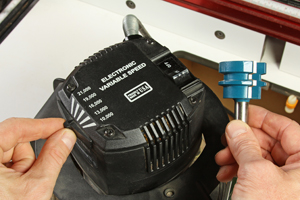
I have an old Craftsman 6.5-amp router that regularly burns wood when cutting with a bearing and template, no matter how new the bit, even carbide. What can I do to avoid that? – Don Baker
Chris Marshall: If your router doesn’t haven’t have variable-speed control, it could be spinning the bits too quickly … and fast cutters held against wood equals heat buildup and burning. Try increasing your feed rate. The faster the cutter gets through the wood, the less heat it builds up. Or, if the machine has variable speed, throttle it back some. For cutters up to 1-inch in diameter, try 20,000 rpm instead of full power. For one- to two-inch diameter cutters, reduce the speed to around 18,000. Take about 2,000 rpm off the speed setting for every 1/2 inch the cutter diameter increases from there, or follow the recommended speed guideline that is provided with the bit.
Tim Inman: That old router may be turning at a very high rate of speed — too high for your cutters. Old routers were not made with the vision of “shaper-sized” cutting bits like we have available to us today. They used very small diameter bits and were used for small jobs. Today’s cutters are much larger diameter (faster tip or surface speeds) and need a somewhat slower rpm to work properly. An old router might have bad bearings, too. Another possiblity is that you might be making too heavy a cut in one pass. Can you avoid burning with lighter cuts? Taking off less wood with each pass lets you increase the feed speed, which should decrease the chance of a burn, plus it is easier on the cutter, you and the router. Hogging off too much in one shot usually means slow feed speeds, hot bits and hot routers — and sweat on my brow from both work and worry.





